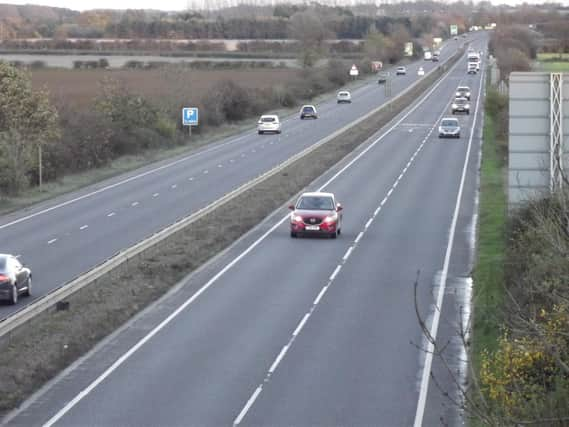UPDATED: Council says bypass, a link road and dual-carriage on A17 would make Sleaford traffic faster and safer


The council discussed the draft transport strategy put forward by Lincolnshire County Council to improve transport around the town over the next decade at its latest executive board meeting.
Among short term goals are several major works which could be explored and potentially bring huge changes to the road network, but they would need feasibility studies before they would be formally adopted.
Advertisement
Hide AdAdvertisement
Hide AdA southern bypass around Sleaford is one of the major ideas.
A feasibility study would be needed to determine whether improved journey times and congestion would be worth the cost and environmental impact.
There is also the suggestion of turning the A17 within the strategy area into a dual-carriageaway.
The report to the NKDC executive board says that the single carriageway portion is liable to congestion, which slows business and infuriates drivers.
Advertisement
Hide AdAdvertisement
Hide AdThe single lane portion of the A17 is also significantly more dangerous than the double lane areas, with six fatal accidents in the last five years.
“Statistically, drivers are three times more likely to be in a fatal or serious accident on a single carriageway than on a dual carriageway, so dualling this road could decrease road deaths,” the report says.
The draft strategy also raises the prospect of a link road to help drivers get to the town centre, bridging East Gate to Boston Road – a project that has been mooted for many years.
“Currently for drivers, it is an 800m journey to get from Lafford Terrace on Eastgate to the Leisure Centre on Boston Road, despite these locations being 100m apart,” it says.
Advertisement
Hide AdAdvertisement
Hide Ad“Building a road and bridge between these locations could have a number of potential benefits, such as faster journey times on the proposed route and through the Town Centre, creating better access for developments close to the link, with the potential for new businesses opening.”
The county council strategy will be used to shape the future of travel until 2036.
North Kesteven District Council Leader Coun Wright said: “Our Executive Board has agreed to endorse the current draft version of the refreshed Sleaford Transport Strategy, which is being shaped by Lincolnshire County Council, as part of our continued engagement in it as a key partner and stakeholder.
“Refreshing the strategy presents an opportunity to build on the previous Sleaford Transport Strategy which dates from 2015, and take into account the changes which have occurred since then including projects now delivered plus our own renewed and urgent focus on climate and the role that key interventions such as reducing congestion and enabling more active travel can play.
Advertisement
Hide AdAdvertisement
Hide Ad“The draft as it stands provides a positive and wide-ranging strategy setting out a number of potential interventions and opportunities to improve transport to and from, as well as within and across Sleaford and its surrounding villages. We’ll engage with the county council as the strategy continues to be developed and finalised.”
Executive board member Coun Mervyn Head said: “It’s important to look at the modes of transport we use, and invest in the right ones at the right time.
“The biggest problem will be cost constraint. We would all like to see lots of things in this implemented, but it is a very big step forward.
“We should support it and hope Lincolnshire County Council will implement much of it, subject to finance being available.”
Advertisement
Hide AdAdvertisement
Hide AdThe document also lays out plans to improve Sleaford’s cycling and walking network, increase bus service reliability and enable motorists to switch to electric vehicles.
There are also hopes to improve ‘pinch point’ junctions and the location of car parking.
Coun Richard Davies, Lincolnshire County Council executive member for highways, said: “We’re still working on the final version of Sleaford’s new transport strategy, and it’s important to note that the one endorsed by NKDC is a very early draft.
“At the moment, we’re sifting through the various ideas and improvements in this early draft. That means prioritising and removing some of them based on a number of factors, including the benefits each one offers and each one’s affordability, deliverability, and benefit-to-cost ratio.
Advertisement
Hide AdAdvertisement
Hide Ad“The final version of the strategy is set to be reviewed and discussed by our Highways and Transport Scrutiny Committee later this year – most likely in September. Around this time, the final document will also be available on the county council website.
“Once the final version of the strategy is complete, the challenge will be finding the funding needed to make the improvements outlined in the document a reality.”
-Lincolnshire County Council has also begun the process of updating its Minerals and Waste Local Plan which is used by developers when putting forward proposals, and by the council when dealing with planning applications.
Lincolnshire is currently the largest producer of sand and gravel in the East Midlands. Limestone, chalk, and hydrocarbons are also extracted in the county.
Advertisement
Hide AdAdvertisement
Hide AdWaste management facilities are essential to ensure the wastes generated by households, businesses and industry are dealt with in the most efficient and sustainable ways possible.
The county council has produced a consultation document which sets out the main issues affecting how it plans for minerals and waste in Lincolnshire together with potential options for improving the plan. They have then posed a range of questions to seek local views on the most appropriate way forward.
In parallel, they are carrying out a ‘call for sites’ exercise to give landowners, the industry and other interested parties an opportunity to nominate potential sites for allocation in the updated plan for sand and gravel and limestone aggregates.
Find further details at www.letstalk.lincolnshire.gov.uk/minerals-and-waste-local-plan-issues-and-options-consultation.
More stories:
Advertisement
Hide AdAdvertisement
Hide Ad